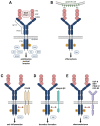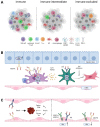Intrinsic and Extrinsic Control of Hepatocellular Carcinoma by TAM Receptors
- PMID: 34771611
- PMCID: PMC8582520
- DOI: 10.3390/cancers13215448
Intrinsic and Extrinsic Control of Hepatocellular Carcinoma by TAM Receptors
Abstract
Hepatocellular carcinoma (HCC) is the major subtype of liver cancer, showing high mortality of patients due to limited therapeutic options at advanced stages of disease. The receptor tyrosine kinases Tyro3, Axl and MerTK-belonging to the TAM family-exert a large impact on various aspects of cancer biology. Binding of the ligands Gas6 or Protein S activates TAM receptors causing homophilic dimerization and heterophilic interactions with other receptors to modulate effector functions. In this context, TAM receptors are major regulators of anti-inflammatory responses and vessel integrity, including platelet aggregation as well as resistance to chemotherapy. In this review, we discuss the relevance of TAM receptors in the intrinsic control of HCC progression by modulating epithelial cell plasticity and by promoting metastatic traits of neoplastic hepatocytes. Depending on different etiologies of HCC, we further describe the overt role of TAM receptors in the extrinsic control of HCC progression by focusing on immune cell infiltration and fibrogenesis. Additionally, we assess TAM receptor functions in the chemoresistance against clinically used tyrosine kinase inhibitors and immune checkpoint blockade in HCC progression. We finally address the question of whether inhibition of TAM receptors can be envisaged for novel therapeutic strategies in HCC.
Keywords: Axl; MerTK; TAM; Tyro3; chemoresistance; hepatocellular carcinoma; receptor tyrosine kinase; therapy; tumor microenvironment.
Conflict of interest statement
The authors declare no conflict of interest.
Figures




Similar articles
-
Tyro3, Axl, and Mertk receptors differentially participate in platelet activation and thrombus formation.Cell Commun Signal. 2018 Dec 12;16(1):98. doi: 10.1186/s12964-018-0308-0. Cell Commun Signal. 2018. PMID: 30541554 Free PMC article.
-
Targeting Tyro3, Axl and MerTK (TAM receptors): implications for macrophages in the tumor microenvironment.Mol Cancer. 2019 May 14;18(1):94. doi: 10.1186/s12943-019-1022-2. Mol Cancer. 2019. PMID: 31088471 Free PMC article. Review.
-
From MASH to HCC: the role of Gas6/TAM receptors.Front Immunol. 2024 Jan 17;15:1332818. doi: 10.3389/fimmu.2024.1332818. eCollection 2024. Front Immunol. 2024. PMID: 38298195 Free PMC article. Review.
-
Galectin-3 Stimulates Tyro3 Receptor Tyrosine Kinase and Erk Signalling, Cell Survival and Migration in Human Cancer Cells.Biomolecules. 2020 Jul 11;10(7):1035. doi: 10.3390/biom10071035. Biomolecules. 2020. PMID: 32664510 Free PMC article.
-
Phosphatidylserine Sensing by TAM Receptors Regulates AKT-Dependent Chemoresistance and PD-L1 Expression.Mol Cancer Res. 2017 Jun;15(6):753-764. doi: 10.1158/1541-7786.MCR-16-0350. Epub 2017 Feb 9. Mol Cancer Res. 2017. PMID: 28184013 Free PMC article.
Cited by
-
PRAME Is a Novel Target of Tumor-Intrinsic Gas6/Axl Activation and Promotes Cancer Cell Invasion in Hepatocellular Carcinoma.Cancers (Basel). 2023 Apr 22;15(9):2415. doi: 10.3390/cancers15092415. Cancers (Basel). 2023. PMID: 37173882 Free PMC article.
-
GAS6/TAM Axis as Therapeutic Target in Liver Diseases.Semin Liver Dis. 2024 Feb;44(1):99-114. doi: 10.1055/a-2275-0408. Epub 2024 Feb 23. Semin Liver Dis. 2024. PMID: 38395061 Free PMC article.
-
Diagnostic Efficacy and Possible Underlying Mechanisms of Noninvasive Clinical Markers in Hepatocellular Carcinoma.J Clin Transl Hepatol. 2023 Aug 28;11(4):889-898. doi: 10.14218/JCTH.2022.00285. Epub 2023 Jan 28. J Clin Transl Hepatol. 2023. PMID: 37408805 Free PMC article.
-
The effect of Lupinus angustifolius supplementation in laying hens on the liver proteome profiles and the concentration of acute phase proteins in serum and liver.Poult Sci. 2025 Jul 3;104(10):105507. doi: 10.1016/j.psj.2025.105507. Online ahead of print. Poult Sci. 2025. PMID: 40633312 Free PMC article.
-
Navigating TAM receptor dynamics in tumour immunotherapy.Cancer Immunol Immunother. 2025 Mar 15;74(5):146. doi: 10.1007/s00262-024-03879-z. Cancer Immunol Immunother. 2025. PMID: 40088262 Free PMC article. Review.
References
-
- Furuta M., Ueno M., Fujimoto A., Hayami S., Yasukawa S., Kojima F., Arihiro K., Kawakami Y., Wardell C.P., Shiraishi Y., et al. Whole genome sequencing discriminates hepatocellular carcinoma with intrahepatic metastasis from multi-centric tumors. J. Hepatol. 2017;66:363–373. doi: 10.1016/j.jhep.2016.09.021. - DOI - PubMed
Publication types
Grants and funding
LinkOut - more resources
Full Text Sources
Research Materials
Miscellaneous

